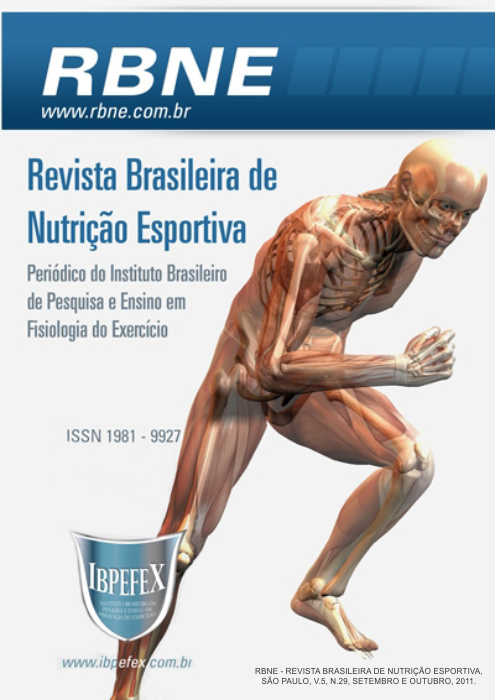Body composition and dietary profile of adolescents volleyball athletes at the Universtiy of Caxias do Sul -RS
Abstract
This study has the objective to identify the body composition and to describe the nutritional profile of teenagers that practice volleyball at the Universtiy of Caxias do Sul. Methodology: This is a transversaland descriptive study. The sample was composed by 74 volleyball athletes between 11 and 17 years old. In the research, the information collected related to body composition were weight, height, skin folds and the nutritional profile with the use of a nutritional survey. Results: 40,54% of the athletes were males and 59,46% were females. The average age of both genders was 13±2,2 years. It was observed that the boys are taller and heavier than the girls, but they have less percentage of body fat. Concerningto the nutritional state, the boys showed bigger weight excess (53,34%), while the girls showed bigger appropriate weight (70,45%). The food ingestion of the athletes demonstrated that the boys consume 22% more calories than the girls, and the girls are consuming less carbohydrates and more lipids than the male athletes. Conclusion: The body composition of the volleyball athletes of the Universtiy of Caxias do Sul showed that it is in accordance with the parameters found in other researches and the nutritional profile is closed to what the Sociedade Brasileira de Medicina do Esporte recommends about the distribution of macro nutrients.
References
-Almeida, T.A.; Soares, E.A. Perfil dietético e antropométrico de atletas adolescentes de voleibol. Rev Bras Med Esporte. Vol. 9, Núm. 4. 2003.
-American Dietetic Association, American College Sports Medicine, Dietitians of Canada.Joint Position Statement.Nutrition and athetic performance. Med Sci Sports Exerc. Vol. 32. Núm. 21. p.30-45. 2000.
-Beals, K.A. Eating behaviors, nutritional tatus,and menstrual function in elite female adolescentvolleyball players. J Am Diet Assoc. Vol. 102. Núm. 9. p.1293-6. 2002.
-Hassapidou, M.N.; Manstrantoni, A. Dietary intakes of elite female athletes in Greece. J Hum Nutr Diet. Vol. 14. Núm .5. p.391-6. 2001.
-Braga, R.K.; Tkac, C.M. Perfil de Estado Nutricional e Antrométrico de Meninas Participantes de Projeto de Iniciação Esportiva na Modalidade Voleibol. Rev. Bras. Educ. Fis. Esp. São Paulo, Vol. 20, p.395-401, 2006.
-Diretrizes da Sociedade Brasileira de Medicina do Esporte. Modificações Dietéticas. Suplemento. Rev Bras Med Esporte. Vol. 15, Núm. 2, 2009.
-DRI, Institute of Medicine, Dietary reference intakes for Energy, Carbohydrates, Fiber, Fat, Fatty Acids, Cholesterol, Protein and Amino Acids(Macronutrients), http://www.nap.edu, copyright 2002, The National Academy of Science
-Fleck, S.J. Body composition of elite Americanathletes. Am J Sports Med. Vol. 11. p. S398-403. 1983.
-GarciaJunior, P.F. Análise do Perfil Antropométrico da Equipe de Basquete Feminino sub-21 de Jaboticabal, SP. Rev. Dig. Buenos Aires, Ano 13, Núm. 129, 2009.
-Gomes, R.V.; Ribeiro, S.M.; Veibig, R.F.; Aoki, M.S. Consumo Alimentar e Perfil Antropométrico de Tenistas Amadores e Profissionais. Rev. Bras. Med. Esporte. Vol. 15, Núm. 6. 2009.
-Hill, R.J.; Davies, P.S.W. Energy intake and energy expenditure in elite lightweight female rowers. Med Sci Sports Exerc. Vol. 34. Núm.11. p. 1823-29. 2002.
-Lukaski, M.C. Vitamin and Mineral Status: Effects onphysical perfonce. Nutrition. Vol. 20, p. 632-44, 2004.
-Morrow, J.R.; Jackson, A.S.; Hosler, W.W.; Kachurik, J.K. The importance of strength, speed and body size for team success in women’s intercollegiate volleyball. Res Q Exerc Sport. Vol. 50. p.429-37.1979.
-Mullinix, M.C.; e colaboradores. Dietary intake of female US soccer players. Nutr Res. Vol. 23. Núm. 5. p.585-93. 2003.
-Nascimento, O.V.; Alencar, F.H. Perfil do Estado Nutricional do Atleta Adulto. Fit.Perf J. Rio Janeiro, Vol.6. Núm. 4, p. 242-246. 2007.
-Panza, V.P.; e colaboradores Consumo alimentar de atletas: recomendações nutricionais. Rev. Nut. Campinas, Vol. 20. Núm. 6. p. 681-692, 2007.
-Pollock, A. V. Surgical Sepsis. Ed. C.J.L. Strachan; R.Wise. Academic Press, London.p.93-100. 1979.
-Ribeiro, K.S.; e colaboradores. Perfil alimentar de atletas adolescentes nadadores. Revista Brasileira de Nutrição Esportiva, São Paulo. Vol. 3, Núm. 16.p 331-339. 2009.
-Santos, J.S.; e colaboradores. Perfil antropométrico e consumo alimentar de adolescentes de Teixeira de Freitas -Bahia. Rev. Nutr. Vol.18, Núm. 5, p.623-632. 2005.
-Schutz, L.K. Volleyball. Phys Med Rehabil Clin N Am. Vol. 10. p. 19-34. 1999.
-Staren, W.A.; Boer, J.O.; Burema, J. Vatidity and reproducibility of a deitaryhistory metrod estimanting the usual food intake duringone month. Am J Clin Nutri. Vol. 42. p.554-9. 1985.
-Thompson, F.E.; Byers, T. Dietary Assessment Resouce Manual. J. Nutr. Vol. 124. Núm. 11.p. 2245s-2317s. 1994.
-Vieira, J.L.L.; Amorim, H.Z.; Vieira, Lenamar Fiorese.; Amorim, A.C.; Rocha, P.G.M. Distúrbios de Atitudes Alimentares e Distorção da Imagem Corporal no Contexto Competitivo da Ginástica Rítmica. Rev. Bras. Med. Esporte. Vol. 15, Núm. 6. 2009.
-World Health Organization.Child Growth Standards. Lenght/Height-for-age, weight-for-age, weight-for-lenght, weinght-for-height and body mass index-for-age. Methods and devenlopment. WHO (nonserial publication). Geneva, Switzerland: WHO, 2006.
-Ziegler,P.J.;Jonnalagadda,S.J.;Lawrence,C.Dietary intake of elite figure skating dancers. Nutr Res.Vol. 21. Núm. 7. p. 983-92. 2001.
Authors who publish in this journal agree to the following terms:
- Authors retain the copyright and grant the journal the right of first publication, with work simultaneously licensed under the Creative Commons Attribution License BY-NC which allows the sharing of the work with acknowledgment of the authorship of the work and initial publication in this journal.
- Authors are authorized to enter into additional contracts separately for non-exclusive distribution of the version of the work published in this journal (eg, publishing in institutional repository or book chapter), with acknowledgment of authorship and initial publication in this journal.
- Authors are allowed and encouraged to post and distribute their work online (eg, in institutional repositories or on their personal page) at any point before or during the editorial process, as this can bring about productive change as well as increase impact and impact. citation of published work (See The Effect of Free Access).






